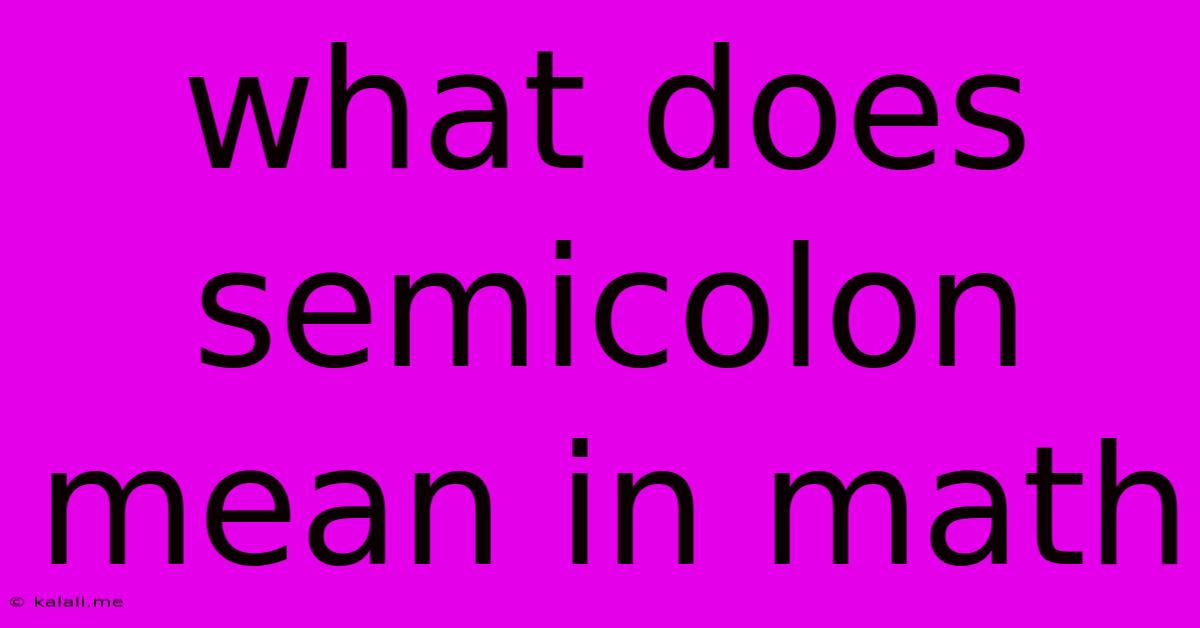What Does Semicolon Mean In Math
Kalali
Jun 09, 2025 · 3 min read

Table of Contents
What Does a Semicolon Mean in Math? A Comprehensive Guide
The semicolon (;) in mathematics isn't as widely used as symbols like +, -, ×, or ÷. Unlike other mathematical symbols with fixed meanings, the semicolon's function is context-dependent. It primarily serves as a separator, but its specific role depends heavily on the surrounding mathematical notation and the broader context of the problem or statement. This article will explore the various ways semicolons are used in mathematical writing.
Understanding the Context is Key
The most crucial aspect of deciphering a semicolon's meaning in a mathematical context is understanding the surrounding elements. It doesn't have a single, universally defined mathematical operation. Instead, its function is more akin to punctuation than an arithmetic operator. Let's examine the common scenarios where you might encounter semicolons in mathematical writing:
1. Separating Multiple Equations or Statements
In many cases, a semicolon acts as a separator between independent mathematical statements or equations within a larger system or problem. This is particularly common in:
-
Systems of Equations: Consider a system of linear equations:
2x + y = 5; 3x - y = 1Here, the semicolon cleanly separates the two equations, indicating that both must be considered simultaneously to find the solution. This is a clear and concise way of presenting a system compared to writing each equation on a separate line. -
Listing Conditions or Constraints: Semicolons can delineate different conditions within a problem. For example, a problem might state:
Solve for x where x > 0; x < 10; x is an integer.The semicolons separate the three conditions that x must satisfy. -
Sequences of Statements in Proofs or Algorithms: In formal mathematical proofs or algorithmic descriptions, semicolons can separate successive steps or statements, enhancing the clarity and readability of the process.
2. Separating Elements in Ordered Sets or Lists
Although less common than other separators like commas, a semicolon can separate elements in an ordered set or list, especially when commas are already being used internally within the listed items. This usage is usually specific to the author's style.
For example, imagine listing sets of coordinates:
(1,2); (3,4); (5,6)
Here, the semicolon improves readability by differentiating between distinct sets. However, the comma would be the more frequently used separator in most mathematical contexts.
3. In Programming and Computational Mathematics
In programming languages and computational mathematics, the semicolon often acts as a statement terminator, signaling the end of a command or instruction. This usage is specific to programming syntax and is not part of standard mathematical notation. This meaning is fundamentally different from the semicolon's usage in purely mathematical texts.
When Semicolons Are Not Used
It's important to note that semicolons are not essential for conveying most mathematical ideas. Their use is largely for stylistic clarity and to improve the organization of complex mathematical statements. Commas, colons, or simply using separate lines or paragraphs can frequently accomplish the same objective.
In Conclusion
The meaning of a semicolon in mathematics depends entirely on the context. While it generally serves as a separator, understanding its precise role requires careful examination of the surrounding mathematical expressions and the overall structure of the problem or argument. While not a core mathematical symbol, its judicious use can significantly improve the clarity and readability of mathematical writing.
Latest Posts
Latest Posts
-
Mi Familia Fuera La M S Grande Correct Incorrect
Jul 01, 2025
-
How Much Is 20 Pounds Of Pennies Worth
Jul 01, 2025
-
How Much Does A Gallon Oil Weigh
Jul 01, 2025
-
How Many Crackers In A Sleeve Of Saltines
Jul 01, 2025
-
How Many Years Are In 48 Months
Jul 01, 2025
Related Post
Thank you for visiting our website which covers about What Does Semicolon Mean In Math . We hope the information provided has been useful to you. Feel free to contact us if you have any questions or need further assistance. See you next time and don't miss to bookmark.